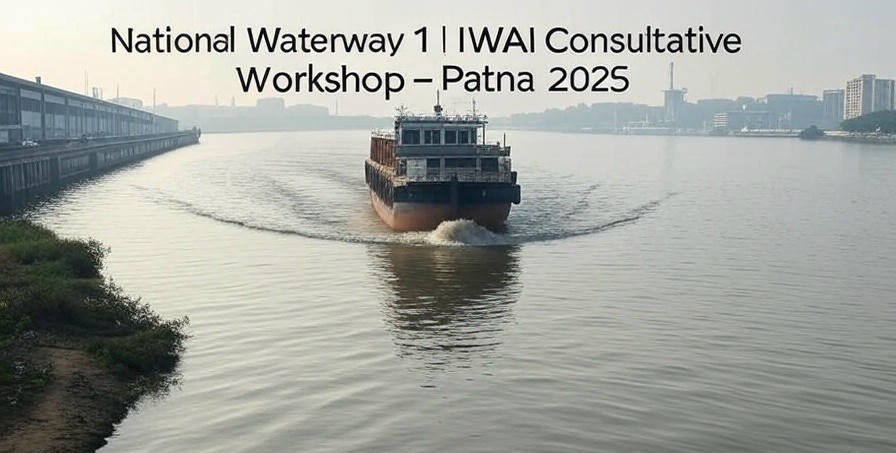
Patna | In a significant step toward transforming inland waterway infrastructure in Eastern India, the Inland Waterways Authority of India (IWAI) is hosting a high-level Consultative Workshop on the development of National Waterway 1 (NW-1) under the Jal Marg Vikas Project (JMVP). Held in Patna for the first time, this inter-ministerial workshop aims to drive policy, technical dialogue, and regional collaboration across states along the Ganga.
Also Read: PM GatiShakti: 95th Network Planning Group Reviews Key Metro, Highway, and Logistics Projects
Table of Contents
The workshop is chaired by Union Minister of Ports, Shipping & Waterways, Shri Sarbananda Sonowal, and includes the participation of key policymakers such as Union Minister of Textiles Shri Giriraj Singh, Minister of State for Ports Shri Shantanu Thakur, Bihar’s Water Resources Minister Vijay Chaudhury, Transport Minister Sheela Kumari, and Uttar Pradesh Transport Minister Dayashankar Singh. Senior technocrats, infrastructure experts, and state and central government officials are also present to enrich the discourse.
Regional Collaboration to Unlock NW-1’s Potential
The workshop focuses on reviewing the 11-year trajectory of cargo movement along the Ganga stretch covering Bihar, Uttar Pradesh, Jharkhand, and West Bengal. Discussions are centered on enhancing the capacity, sustainability, and economic integration of inland waterway transport (IWT) systems.
IWAI Chairman Vijay Kumar (IAS) expressed optimism about the initiative, stating:
“This workshop marks a critical milestone in our commitment to revitalising inland water transport. Patna, as a first-time host, is poised to become a pivotal hub on the Varanasi-Haldia corridor of NW-1. Our agenda today will help identify actionable strategies to improve cargo and passenger movement, unlock regional trade potential, and bolster hinterland connectivity.”
Jal Marg Vikas Project: A Vision for Sustainable Connectivity
The Jal Marg Vikas Project (JMVP) is spearheading a transformation in river-based transport by addressing long-standing challenges through targeted infrastructure upgrades. Key interventions under JMVP include:
- Fairway development to ensure minimum navigable depth
- Construction of multimodal terminals for seamless cargo transfer
- Installation of navigational locks and aids for safe transit
- Development of community jetties to promote local participation
- Enhanced river management systems
These efforts are part of a broader push to shift cargo movement from congested road and rail networks to a more sustainable and cost-effective water-based mode.
A Gateway to Economic Growth
With logistics and transport forming the backbone of regional development, NW-1 holds immense potential for reducing carbon emissions, lowering transport costs, and stimulating economic activity across the eastern corridor.
The outcomes of this consultative workshop are expected to provide a roadmap for integrating IWT into India’s multimodal logistics vision and advancing the national commitment to green and inclusive infrastructure growth.
A Critical Look at NW-1 and the Future of Inland Waterways
While the development of National Waterway 1 (NW-1) through the Jal Marg Vikas Project (JMVP) is often hailed as a transformative step for sustainable logistics and regional trade, it is crucial to critically examine the broader implications of such an ambitious infrastructure initiative.
Undeniably, NW-1 offers significant potential — including reduced transport costs, lower carbon emissions, and decongestion of road and rail networks. However, the success of this inland waterway hinges on several under-addressed challenges:
- Ecological Sensitivity of River Ganga
The Ganga is not just a waterway; it is an ecologically sensitive and culturally sacred river. Dredging, barge movement, and construction of river ports pose risks to aquatic biodiversity, riverbank erosion, and water quality. Critical voices from environmental groups have raised concerns over the lack of cumulative impact assessments, especially in the biodiversity-rich stretches near Bihar and West Bengal.
- Displacement and Livelihoods
The development of multimodal terminals and river-based industrial hubs may lead to displacement of riparian communities and traditional boatmen who depend on the river for livelihood. Without adequate compensation and livelihood rehabilitation, the socio-economic outcomes may prove uneven.
- Multimodal Integration Still in Infancy
Although NW-1 is positioned as a component of India’s multimodal logistics network, true last-mile connectivity via road and rail is still developing. Without seamless coordination across modes, the efficiency gains may remain suboptimal.
The Way Forward: Balancing Development and Sustainability
As India pushes toward inclusive and green infrastructure, inland water transport (IWT) must not only be scaled but also made equitable, environmentally responsible, and technically resilient. The current consultative workshop in Patna provides a timely opportunity to:
- Review long-term ecological impact studies.
- Involve local stakeholders in planning and feedback loops.
- Prioritize adaptive solutions for climate resilience.
- Ensure that infrastructure investments translate into real socio-economic benefits for the hinterland.
Only by embedding critical oversight and multi-stakeholder accountability can NW-1 evolve from a project into a sustainable public good.
